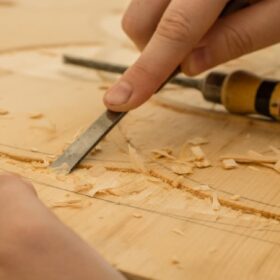Educational, Woodworking Tips
The Woodworking Symbol of Feet and Inches
The Woodworking Symbol of Feet and Inches explained
Making inaccurate measurements is one of the most common mistakes made by beginners in woodworking. This can lead to you buying too much or too little lumber, or cutting wood pieces that don’t add.
These mistakes can be caused by not understanding the woodworking feet and inches symbols. In this comprehensive guide we will provide you with all the information and examples that you need to understand the feet-and-inches symbol for woodworking.
Foot and Inches Symbol
The standard way to represent feet and inches is either by abbreviation, or symbol. IEEE’s standard symbol for a foot is “ft.”. It can also be represented as an apostrophe (‘). So 8′ means eight feet. Inches can be abbreviated as “in.” or, less commonly, “ins.” and are represented by a double prime (“).. 5″ is five inches high.
Why Do We Use Feet and Inches to Measure?
The imperial system is used by the United States, and some other countries. The metric system used centimeters and meters.
One foot equals 12 inches. Inches are the smallest length unit in the imperial system. In the metric system one inch is equal to 2.54 centimeters. This is useful when converting between meters and feet (or centimeters and inches).
The symbols for feet and inches make it easier to understand. Writing 5′ is faster than 5′ or 5 feet. Similarly, writing 2″ is quicker than 2 inches.
It’s easier to combine the two – writing 5’5″ is more convenient than five feet five inches. These can be abbreviated as 5 ft. 2 in., but it doesn’t have quite the same ring.
The abbreviation “m” can be used to represent meters, but it can be confusing because the symbol could mean different things, such as a minute, mile or mass. Once you become familiar with the symbols for inches and feet, you will be able do your work faster.
Why is it important to understand the symbols for feet and inches?
When buying lumber in a lumberyard, or online, you will find that most places only list the dimensions using symbols. It is because the majority of buyers are professionals in the industry and builders who are familiar with the symbols. Therefore, sellers do not feel the need to explain them.
You will see specifications such as 2 x4 x4′ which means that the piece is four inches long, two inches thick and two inches wide. If you do not understand the symbols used for feet and inches, then you will be confused!
What is the symbol of feet?
In general, lumber, boards, sidings and pipes are measured in feet. Footage is used for anything longer than your arm.
It is easier to understand for beginners. Most hardware stores, and even online stores, prefer to use the symbol for feet which is an (‘).. The difference is that inches use a double prime (“).
Take a look at a real life example.
When you visit a lumberyard, nobody has the time to write in inches and feet. Instead, you may see a measure like:
2x4x8′. The board measures two inches thick by four inches wide and eight feet in length. You can also write this as 2in. This can also be shown as 2in. x 4in.
Products can be listed as:
The 2×4 is available in 8-16 foot lengths. The 2×4 lumber is two inches thick and comes in lengths of four inches between 8 and 16 feet. A 2×4 isn’t really two inches thick. It’s actually one and a 1/2 inches thick. We will discuss this in a later article.

What is the Inch Symbol for?
Double quotation marks (“). It can be abbreviated to in. You can also find it abbreviated as ins. For inches. However, many people use in. Both singular and plural forms of the word in are acceptable.
You may find that a small piece basswood is listed as:
The block measures 1.5 inches thick by 1.5 inches wide and 6 inches in length. This can be written as 1.5 x 1,5 x 6 in.
When buying lumber you may not always see the symbol for inches such as:
This means that the piece of lumber is 2″ thick, 4″ wide and 8 feet long. The lumber measures two inches in thickness, four inches in width, and eight foot long. When you hear someone refer to a 2 by 4, or 2 x 4 they are referring to inches.
Why use symbols instead of abbreviations?
You may wonder why symbols are preferred over abbreviations. It is difficult to confuse an abbreviation while the symbols of feet and inches are almost identical.
There are three good reasons to do so.
Speed, for faster denotations
Woodworking takes a lot of time. Saving time is important, so you should do it wherever and however possible. If you work for a company which sells a variety of woodworking tools, you can save a lot by using symbols. It is also useful for tradespeople like carpenters and builders who take measurements constantly.
It can be tedious and repetitive to have to write inches and feet after each number. The symbols are an easy and quick way to measure so that you can get back to your work. It is also quicker to type “than to write inches.
This saves space and allows for more measurements on one page
Practically, you can communicate a lot in a small space because symbols are short. Imagine a blueprint with all the inches and feet written out – for every door, walkways, slabs, walls, steps, shingles, etc. This would be too much information and would also be a very large blueprint.
It is the same if you have to measure wood pieces for a project. In this case, you can save space by writing symbols on the wood. This will make it easier to keep it neat and clean.
Understanding is universal.
Woodworking is not confined to a single country or language. It is easier to work with a common language and a means of communication. Symbols, for example, do not require translation in other languages.
If you are importing products, such as a hardwood floor, the dimensions will be easy to understand. You wouldn’t even need an interpreter when you travel to another country, since distances are represented in symbols.
Converting between feet and inches
We are now at the easy part. It is simple to convert feet into inches or vice versa. One foot equals twelve inches. If the measurement is greater than 12 inches you can convert to feet by multiplying it by
12. To convert inches to feet, multiply 12 by the measurement.
Divide 24 inches by 12 to get 2 feet. If you are converting a number that is not a multiple 12 then there will be a remainder.
Two and ten inch is the result of converting 34 inches into feet. This can be written 2’10”. It’s much easier to convert feet into inches if you multiply by 12. Three feet to inches is three times twelve, which equals 36 inches.
What happens when you need to convert decimal inches to feet? When you buy lumber, the measurements are usually in decimal. For instance, 1.5 x 3.50. If you bought 11 pieces and need to know how many feet the width is, divide 12 by 11.
In this case we are converting from 38.5 inches into feet. So, that would be three feet and two-and-a half inches or 3’2.5″.
How do you measure the dimensions of the lumber board?
We began this article by talking about lumber. It’s only fair that we elaborate a bit. Lumber measurements are among the most simple and misleading in the entire industry. We need to understand the different ways that lumber is measured in order to better understand it.
Dimensional sizing
It is the most popular method of measuring DIY lumber. Lumberyards usually list dimensions only in inches, since they come in different lengths.
As an example, the lumber listed is 2×6 which means two inches thick by six inches wide.
Lumber is sold shorter than the listed dimensions because it was planned from rough logs that were measured. Lumber is usually sold shorter than listed dimensions, because the rough logs used to plan the lumber were smaller. The actual size of a 2×6 lumber would be 1.5 inches thick by 5.5 inches wide.
Quarters sizing
Quarters is the only way to purchase rough-sawn wood. Quarter sizing is the thickness of lumber, which is measured in quarter increments. You may see that the thickness of a board is “4/4”, which means it’s 4 quarters thick or 1 inch.
They assume that you will first plane the lumber, then join it to the desired thickness.
Board foot size
This is the last and most confusing question, but you need to decide if you will buy a large amount of rough-sawn wood. It is cheaper than planked lumber, and sold by board feet (bd). This is equivalent to 144 cubic feet.
Multiply 12 inches by 12 inches and 1 inch thick. Calculate the bd before you buy lumber. Ft. by multiplying both sides together and then dividing 144.
It’s a little more difficult than buying lumber that is already cut, but you will always get the exact dimensions.
For those aspiring to embark on a woodworking career and transform their passion into a profession, exploring cabinet maker jobs can be a rewarding path. Cabinet maker roles involve crafting custom cabinets and furniture, requiring skills in precision, creativity, and attention to detail. Whether you are a seasoned woodworker or just starting in the field, cabinet maker jobs offer the opportunity to contribute to the creation of functional and aesthetically pleasing pieces. Check out these positions to turn your woodworking skills into a career.

FAQs
What is the symbol used for feet and inches in English?
It is not technically a sign, but the first symbol for foot is (ft.). The symbol for feet is actually an apostrophe (‘). The 6 foot measurement becomes 6 ft. Inches are abbreviated as (in.). The abbreviation for inches is (in.) The symbol for inches is the double prime (“). The 4 inch measurement becomes 4 in. Or 4″
How to write the height in feet and inches?
The most common way to write height in feet is with the abbreviation (ft. ) or by using the prime symbol (‘). Five feet, for example, will be written 5 ft. The abbreviation for inches is (in.). or double prime (“). If you want to write 5’5″, then 5’5″ would be 5ft.5in.
How to convert inches into centimeters
It is not common to convert inches into centimeters, but it can be done. You can convert from inches to centimeters easily by multiplying the inch by 2.54. To convert centimeters into inches, divide by 2.54, but this can result in remainders. This is why the conversion is not done often.
How tall is a foot in inches?
Twelve inches is one foot. The Roman Foot was an obsolete unit of measure that measured 11.64 inches. The imperial system foot is the same unit of measurement as the international system (also called the metric or metric-based system).
What is the exact measurement of lumber?
The measurements on the lumber are not exact. A 2×4 would be 2 inches thick by 4 inches wide. It is actually 1.5 inches thick by 3.5 inches wide.
What is the difference between metric and imperial systems?
When it comes down to measuring, the metric system follows a natural progression of millimeters, centimeters and meters. The imperial system, however, does not have a set pattern. You move from 1 inch to 1 foot to 1 yard. A foot is 12 inches and a yard three feet.
Woodworking mistakes are inevitable, but some are more expensive than others. You can avoid costly mistakes in construction, purchasing or measurement by understanding the feet and inch symbols.
The abbreviations may be easy to grasp, but the symbols can take some time to get used to. We have repeated the symbols in this guide a lot to ensure that they are ingrained in your subconscious.
We’ve written a second article to help you understand the sizes of lumber.

